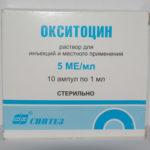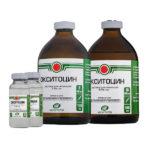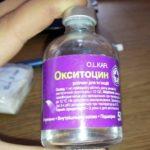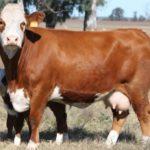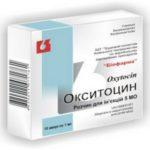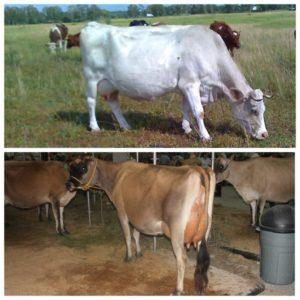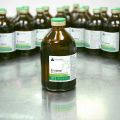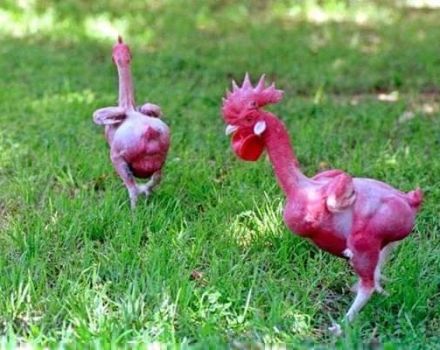Instructions for use for cows Oxytocin, doses for animals and analogues
"Oxytocin" is a veterinary drug for the treatment of animals, which is used according to the instructions for use (exclusively for cows). The drug treats gynecological diseases. The medicine is used to stimulate labor activity, with mastitis, to increase the amount and improve milk flow. Cows are injected at a strictly prescribed dosage.
Description of the veterinary medicine
"Oxytocin" is a veterinary medicine that is used in veterinary medicine. It is used for preventive purposes and for the treatment of gynecological problems in cows. It is a clear, colorless or yellowish solution. Packaged in ampoules or glass bottles, closed with rubber stoppers and aluminum twists. Common packaging: 1, 5, 10-100 milliliters.
The active ingredient is oxytocin. 1 milliliter of veterinary medicine contains 5 units (IU) or 10 units (IU) of the active ingredient. Excipients: nipagin, water for injection. The veterinary drug is completely ready for use. The medicine is used, as a rule, once, at the time of weak labor activity. After the injection, animal meat or milk can be consumed without restrictions.
Properties and pharmacodynamics
"Oxytocin" is referred to as hormonal veterinary drugs. Its active ingredient is a synthetic analogue of a hormone called oxytocin. This substance helps to enhance the contraction of the muscles of the uterus, affects the tone of the myometrium.
The medicine is applied towards the end of the cow's pregnancy, usually during labor.
Veterinary medicine is also used to enhance milk production. After all, oxytocin causes a contraction of secretory cells that surround the alveoli of the mammary glands. The drug stimulates the flow of milk into the large ducts and milk sinuses.
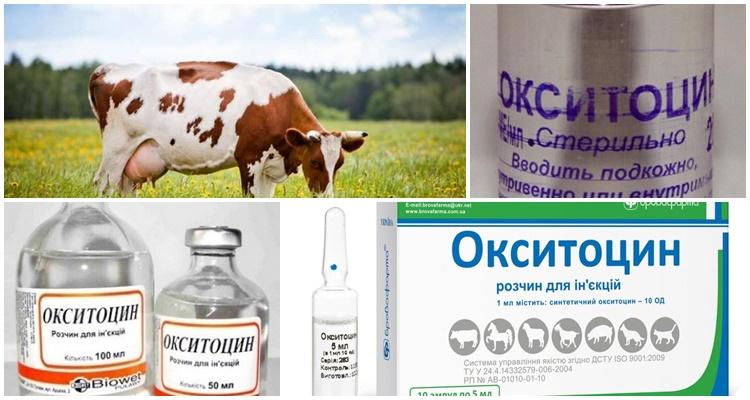
The drug takes effect 1-3 minutes after administration. The healing effect lasts 22-33 minutes. The veterinary drug is administered subcutaneously, intramuscularly or intravenously. The drug has very weak antidiuretic and vasoconstrictor properties. "Oxytocin" does not affect the muscles of the intestines and bladder, does not increase urination or fecal excretion. The drug relaxes vascular smooth muscles, which causes short-term arterial hypotension and reflex tachycardia (increased heart rate). The drug is classified as a low-hazard substance of the fourth class. Oxytocin is metabolized by the liver and excreted by the kidneys.
Appointment, indications for use
Oxytocin injections are prescribed:
- to stimulate labor activity;
- with unexpected uterine bleeding;
- in case of a delay in the release of the placenta;
- with atony and hypotension;
- with inflammatory processes in the uterus;
- with diseases of the udder (mastitis);
- with reflex agalactia.
Instructions for use for cattle
Injections of "Oxytocin" are given to cows only for medicinal purposes. The drug is administered to animals once in a prescribed dose. The drug can be injected before the onset of labor, at the time of labor and after calving. Routes of administration: subcutaneous, intramuscular, intravenous or epidural (in combination with novocaine).
Dosages:
- subcutaneously or intramuscularly - 30-60 IU or 3-6 ml;
- intravenously - 20-40 IU or 2-4 ml;
- epidurally - 15-30 U or 1.5-3 ml.
The dosage of the veterinary medicine depends on the weight of the cow. If the weight of the animal is 350 kg, then the minimum dose is administered, for example, intramuscularly - 3 ml of the drug. If the weight of the cow is 400-500 kg, then the dosage is increased to 6 ml. The injection is done once.
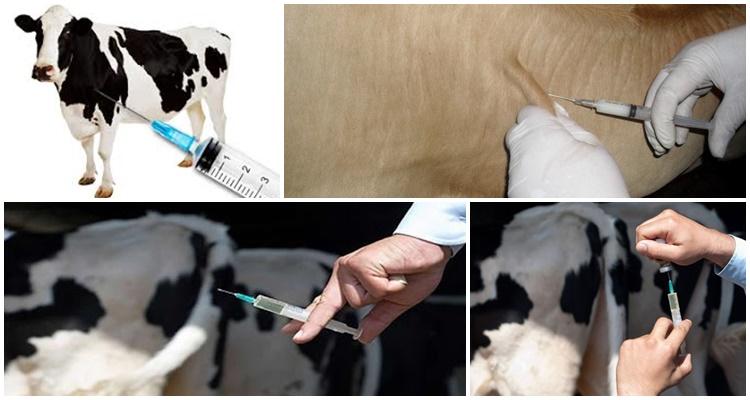
When administered intravenously, "Oxytocin" is pre-diluted with saline. Most often, intramuscular injections are given. In combination with glucose, the effect is achieved faster, however, the dose must be reduced by 30 percent.
Contraindications and side effects
"Oxytocin" is used only at the time of labor activity. The drug is contraindicated in pregnant cows, as it can lead to stimulation of the walls of the uterus and abortion. It is forbidden to do injections of "Oxytocin" if the fetus is too large, has deformities or is positioned incorrectly (not with feet forward).
If you use the veterinary medicine strictly according to the instructions, then side effects and unforeseen complications are not observed.
In rare cases, cows have tachycardia, arterial hypotension. An overdose of this medication can lead to very violent labor. If the dose of the drug is increased several times, then severe bleeding, heart problems in the cow and fetus are possible. In very rare cases, an overdose can kill an unborn calf.
Terms of sale and storage
Oxytocin is sold in almost all veterinary pharmacies. Veterinary medicine for animals can be bought without a prescription. The drug is used if the contractions of the cow stopped during labor. The veterinary medicine is recommended to be used within 2 years from the date of manufacture. It is advisable to store the medicine in a cool dry place at a temperature of 1-10 degrees Celsius (it is possible in the refrigerator). After opening the ampoule or bottle, the unused remains of "Oxytocin" must be poured out.
Analogs
A drug such as "Gipophysin" has a similar effect. This drug stimulates labor pains in cases of uterine hypotension. The drug is used to improve the discharge of the placenta. It is a clear, ready-to-use solution for injection. Carbetocin acts as an active substance in "Gipophysin". It is a synthetic derivative of the hormone oxytocin.
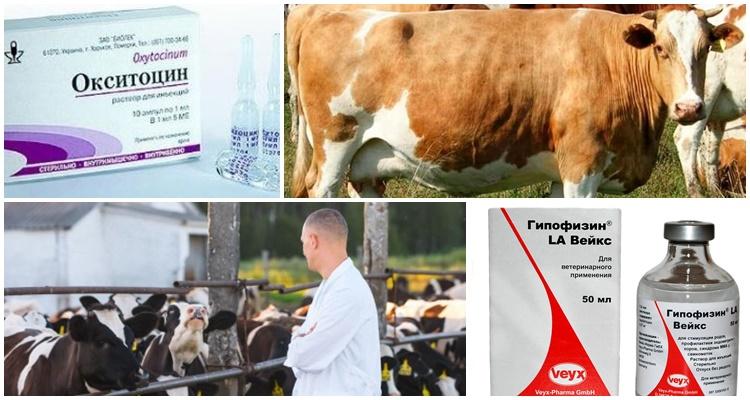
To stimulate labor and in case of retention of the placenta, you can use "Uteroton". It is a non-hormonal agent. "Uteroton" activates the action of natural oxytocin. The veterinary drug is used once at the time of weak labor activity. This is a clear solution for injection based on propranolol hydrochloride. Administered intramuscularly or intravenously (at the time of delivery).
To intensify the attempts at difficult labor in cows, you can use "Broestrofan". This is a hormonal veterinary drug based on cloprostenol. The drug is prescribed when the placenta is retained, to accelerate the involution of the uterus.Sold in ampoules of 2 milliliters. This drug is administered intramuscularly or subcutaneously. The dosage of 2 milliliters is for a 405 kilogram cow. The veterinary drug is prohibited from entering in the early months of pregnancy (miscarriage is possible).
Personal prevention measures
When working with "Oxytocin" it is recommended to follow the sanitary rules. Animals should be injected with clean hands. It is advisable to disinfect the injection site with alcohol. After the injection, hands should be washed with water. It is forbidden to use the drug for animals to humans. Oxytocin should not be taken orally.
If a person is poisoned with this drug, it is necessary to induce vomiting and consult a doctor. If "Oxytocin" gets on the skin or eyes, rinse the contaminated area with plenty of water. People with allergies to the components of the medicinal product are prohibited from working with this medication.

